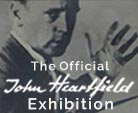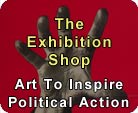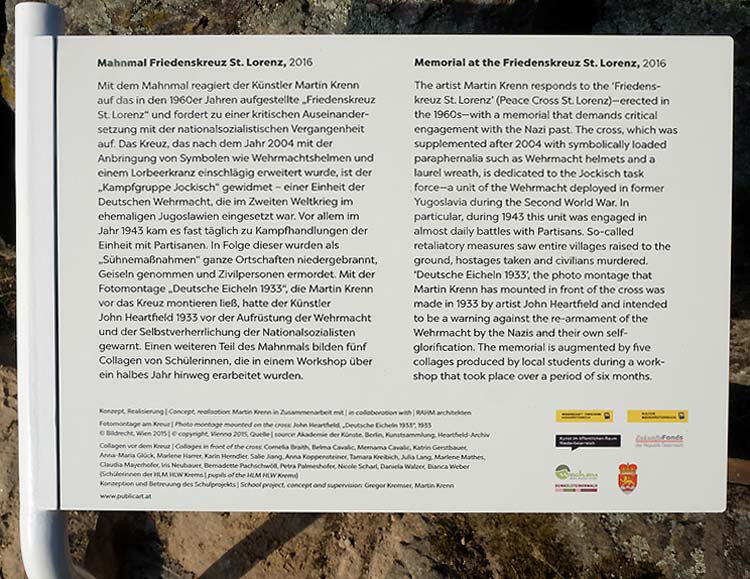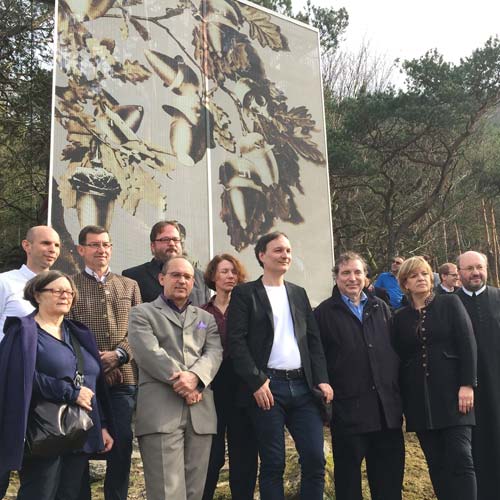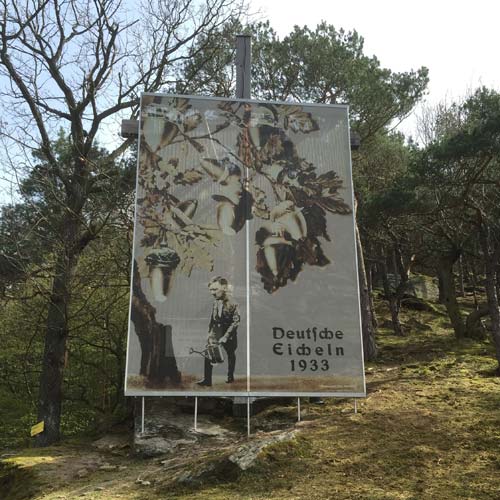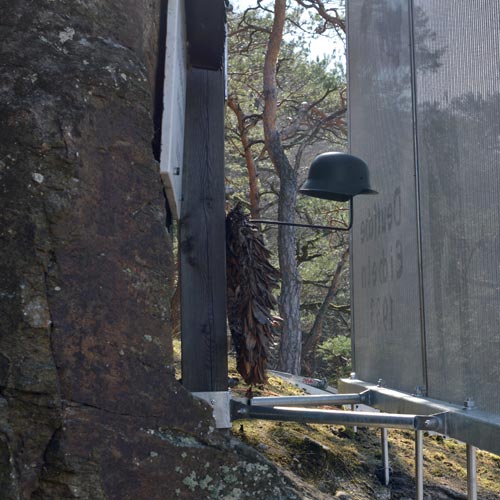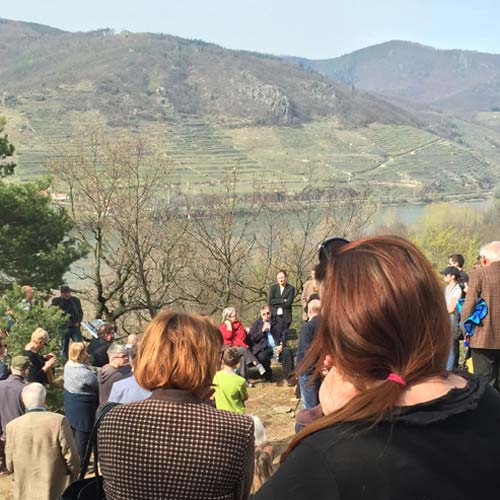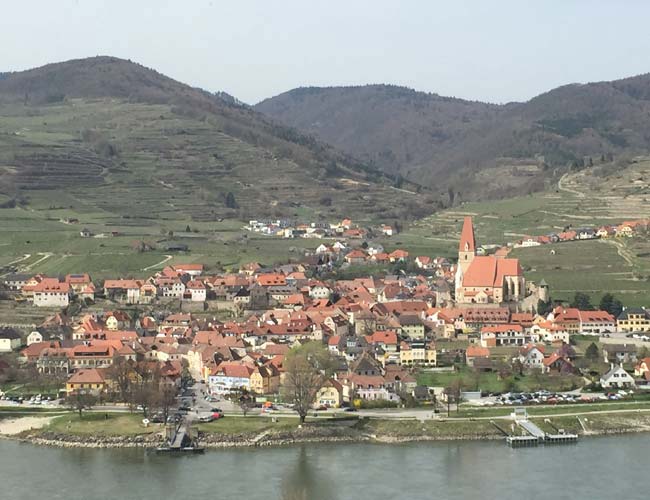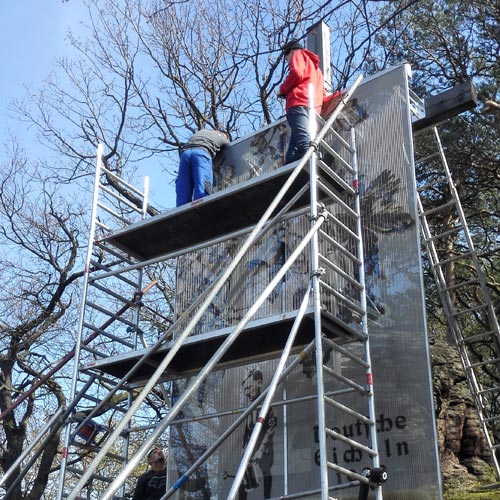
Deutsche Eicheln – 2016 Austrian Political Art Event
Memorial At The Friedenskreuz (Peace Cross) St. LorenzJohn Heartfield’s Deutsche Eicheln (German Acorns)
Deutsche Eicheln(German Acorns)
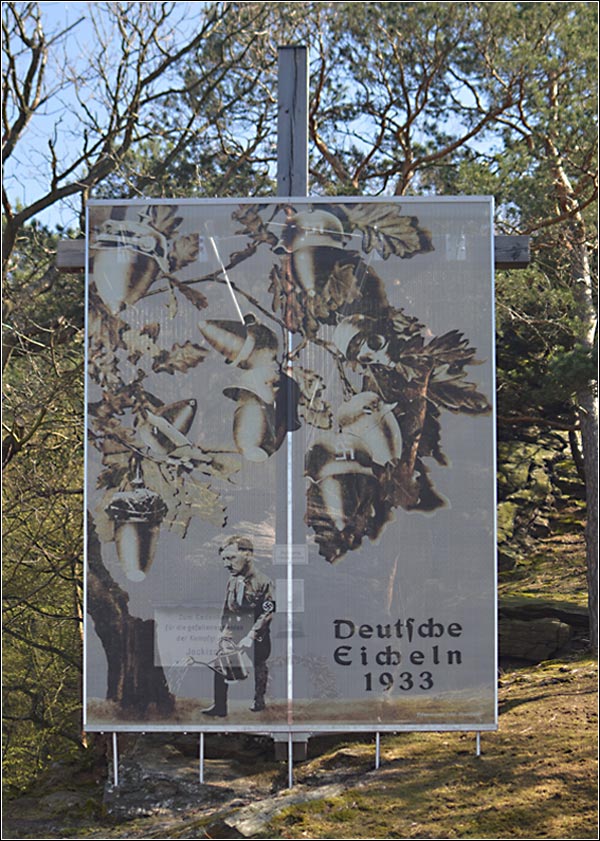
MEMORIAL AT THE FRIEDENSKREUZ ST. LORENZ

MEMORIAL AT THE FRIEDENSKREUZ ST. LORENZ


MEMORIAL AT THE FRIEDENSKREUZ (PEACE CROSS) ST. LORENZ
AN INSPIRING 2016 AUSTRIAN POLITICAL ART EVENT
Austrian artist Martin Krenn supervises the challenging construction of the John Heartfield political photo montage Deutsche Eicheln (German Acorns) in front of the Mahnmal Friedenskreuz (Peace Cross) St. Lorenz, Austria. This plaque describes why St. Lorenz's government was convinced it was important to place John Heartfield's anti-nazi photo montage in front of the Mahnmal Friedenskreuz (Peace Cross) St. Lorenz. Artists, historians, the monument team members, officials, and art lovers gather on the day the inspiring "Memorial at the Friedenskreuz (Peace Cross) St. Lorenz" was unveiled. John Heartfield's political montage is a timeless message that when seeds of hatred and bigotry are sown in the young, a withering crop of war and suffering will soon follow. The John Heartfield Exhibition curator express his gratitude to the artist, Martin Krenn. Herr Krenn was instrumental in winning the St. Lorenz competition and completing the challenging installation. The curator tells Herr Krenn that his grandfather, John Heartfield, would be delighted to see his political photo montage, "Deutsche Eicheln" standing in front of a well-known war memorial to the Wehrmacht. It was his grandfather's core philosophy that his art should be out in the open and available to the people so they might make their own decisions as to its messages and its merit. The permanent transparent 2987 cm x 4280 cm (approximately 98 ft. x 140 ft.) metal and fabric installation of John Heartfield's Deutsche Eicheln stands only a few steps in front of the Friedenskreuz (Peace Cross) St. Lorenz. A view of the Mahnmal Friedenskreuz (Peace Cross) installation from behind John Heartfield's political photo montage. On April 3, 2016, a crowd of Austrian citizens gathers to hear principles and participants in the memorial unveiling speak about the transformative power of art.
The Challenging Construction
Plaque For The Mahnmal Friedenskreuz (Peace Cross) Installation
The Unveiling Of The Memorial At The Friedenskreuz (Peace Cross) St. Lorenz
An Inspired City Planner, A Courageous Mayor, A Brilliant Artist
Memorial At The Friedenskreuz (Peace Cross) St. Lorenz
Another View Of The Installation
Many Perspectives On The New Memorial
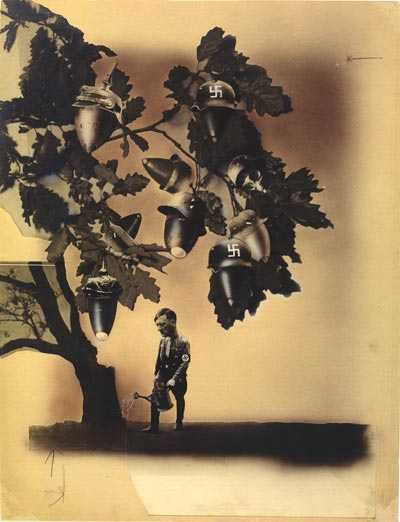
HEARTFIELD’S DEUTSCHE EICHELN
A COMMENTARY ON THE ART
by Andrea Hofmann
The complex symbolism Heartfield packed into this photomontage is astonishing considering the number of days he had to meet the production deadline.
German Acorns graphically shows Hitler’s toxic effect upon healthy growth. Heartfield clearly implies that the Hitler Youth organization was little more than a paramilitary outfit and its military training a covert violation of both The Treaty of Versailles and the Four-Power Pact (signed between Britain, France, Italy, and Germany).
There are distinct similarities between Hitler’s own uniform and Hitler Youth uniforms. However, Heartfield does not dress Hitler in shorts like a Hitler Youth youngster. Although he often employed reality in a satiric or ironic manner to drive home his message, his art was never frivolous. Hitler must be taken seriously because he poses a vital threat to humanity. He is in charge now (the gardener) and looking after affairs (the metal watering can). The outcome is booming militarization (acorns). What seems likes a harmless activity has massive implications. German Acorns makes it crystal clear that Hitler’s domestic policy, the militarization of German children, is bound to have a devastating international impact.
Heartfield does make Hitler appear preposterous by enlarging his head. And, Hitler’s oversized head suggests he is a puppet under the control of war financiers and profiteers. But, Hitler is not portrayed as infantile or ridiculous. He is clearly a highly dangerous scheming strategist.
The oak tree is a German national symbol. It stands for endurance, fortitude, loyalty, and reliability. In short, it is a symbol of strength. The stem of a healthy oak, however, should be upright. In contrast, Heartfield’s oak trunk appears warped and damaged. The tree in Heartfield’s montage is distorted. It’s notable that Hitler is not watering oak saplings, but rather an existing big old tree. This means he is refining and enhancing an existing tradition.
Following this logic, the root cause of the degenerate acorns is the German Empire, the Weimar Republic, chauvinism, militarism, and patriotism. Note also the spiked helmets, which were associated with the Prussian military. The gas mask would be a reference to WWI as well as to the newly founded National Air Raid Protection League.
In addition, Oak leaves are an international symbol of heroism. They are used in many countries. They were used the same way in Nazi Germany. Acorns symbolize potential. They served as SS insignia (a link amplified in this montage by the helmets which sport swastikas).
Acorns usually fall in autumn, especially September. The very month the montage was published. The acorns in Heartfield’s montage are huge and ready to drop. Heartfield is warning of a war in the making. And obviously, the acorns Hitler is growing won’t fall far from the tree. This indicates that Heartfield is warning of another war in Europe.
Besides, some of the acorns have flat tops. These could signify dumdum bullets whose military use was outlawed by the Hague Convention of 1899. Is Heartfield implying Hitler was breaking international law? Is he referring to the horrors of WWI where illegal weapons like dumdum bullets were used despite the Hague Conventions? The injuries that these weapons caused were still part of collective consciousness and experience.
Ultimately, German Acorns challenges the idea that Nazis could be trusted. Hitler’s expression is grim. It is not the face of a beneficent gardener growing healthy crops. Therefore, Heartfield’s montage implicitly questions Neville Chamberlain’s appeasement policy. References to Nazi ‘blood and soil’ ideology and the ‘back to nature’ cult only enhance the grotesque effect of the scene. They support Winston Churchill who had publicly challenged German rearmament and questioned the isolationist policy of the USA.
As so often with a Heartfield photomontage, there is a visual pun. Since Hitler is not your obvious choice as a gardener, the German saying “den Bock zum Gärtner machen” springs to mind. It translates as “to appoint the goat as gardener.” Surely, who would have a goat as their gardener? This is one more dig at Adolf Hitler’s supporters.
Finally, there is the double meaning of “Eichel.” It can mean acorn, but also glans. Perhaps Heartfield is commenting on Hitler’s fantasies of a testosterone-fueled master race? It would just be the kind of sharp-witted satire contained in John Heartfield’s political photomontages, which gives them an extra twist and makes them so much fun to look at even today.
The macho fantasies of Adolf Hitler are also on display in the John Heartfield political photomontage Völkische Tiefenschau, AIZ, August 31, 1933.
